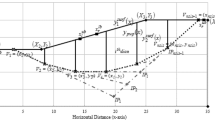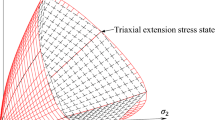Abstract
Rock slopes with planar joints or weak structural planes are vulnerable in nature, especially suffering from the natural hazards, instabilities of slopes are more prone to occur. Therefore, concerning to the influence of earthquakes, this paper performs a new procedure to evaluate slope stability in a geomaterial governed by Hoek–Brown strength criterion. A rotational failure mechanism determined by 21 dependent angle variables is introduced to respect the Hoek–Brown strength criterion. The earthquake load is characterized by a modified pseudo-dynamic method that does not violate the zero boundary condition and considers the damping properties of geomaterials. A slice approach is adopted to calculate the earthquake-induced inertial force work rate. The stability number of rock slope is considered to measure the safety. The stability number is formulated as a classical optimization problem controlled by 21 dependent angle variables and a time variable which need to be optimized by the genetic algorithm toolbox. Comparisons with the literature are made to prove rationality and accuracy of the proposed procedure. Parametric study is carried out to reveal the influence of dynamic properties. For engineering application, stability charts are provided for a quick assessment of slope safety.















Similar content being viewed by others
References
Baker R (2003) Inter-relations between experimental and computational aspects of slope stability analysis. Int J Numer Anal Meth Geomech 27(5):379–401
Bellezza I (2014) A new pseudo-dynamic approach for seismic active soil thrust. Geotech Geol Eng 32(2):561–576
Bonilla-Sierra V, Scholtes L, Donze FV, Elmouttie MK (2015) Rock slope stability analysis using photogrammetric data and DFN–DEM modelling. Acta Geotech 10(4):497–511
Cen DF, Huang D, Ren F (2017) Shear deformation and strength of the interphase between the soil-rock mixture and the benched bedrock slope surface. Acta Geotech 12(2):391–413
Deng DP (2020) Limit equilibrium solution for the rock slope stability under the coupling effect of the shear dilatancy and strain softening. Int J Rock Mech Min Sci 134:104–421
Dong S, Feng WK, Yin YB, Hu R, Dai HC, Zhang GQ (2020) Calculating the permanent displacement of a rock slope based on the shear characteristics of a structural plane under cyclic loading. Rock Mech Rock Eng 53(10):4583–4598
Ghosh P, Kolathayar S (2011) Seismic passive earth pressure behind non vertical wall with composite failure mechanism: pseudo-dynamic approach. Geotech Geol Eng 29(3):363–373
Ghosh S (2010) Pseudo-dynamic active force and pressure behind battered retaining wall supporting inclined backfill. Soil Dyn Earthq Eng 30(11):1226–1232
He Y, Liu Y, Hazarika H, Yuan R (2019) Stability analysis of seismic slopes with tensile strength cut-off. Comput Geotech 112:245–256
Hoek E, Brown ET (1980) Empirical strength criterion for rock masses. J Geotech Eng Div 106(9):1013–1035
Hoek E, Carranza-Torres C, Corkum B (2002) Hoek–Brown failure criterion-2002 edition. Proc NARMS-Tac 1:267–273
Kramer SL (1996) Geotechnical earthquake engineering. Pearson, NJ
Kumar P (1998) Shear failure envelope of Hoek–Brown criterion for rockmass. Tunnel Undergr Space Technol 13(4):453–458
Michalowski RL, Park D (2020) Stability assessment of slopes in rock governed by the Hoek–Brown strength criterion. Int J Rock Mech Min Sci 127:104–217
Nimbalkar SS, Choudhury D, Mandal JN (2006) Seismic stability of reinforced-soil wall by pseudo-dynamic method. Geosynth Int 13(3):111–119
Pan QJ, Jiang YJ, Dias D (2017) Probabilistic stability analysis of a three-dimensional rock slope characterized by the Hoek–Brown failure criterion. J Comput Civ Eng 31(5):04017046
Pan QJ, Dias D, Sun Z (2017) A new approach for incorporating Hoek–Brown failure criterion in kinematic approach-case of a rock slope. Int J Struct Stabil Dyn 17(7):177–1008
Qin CB, Chian SC (2017) Kinematic analysis of seismic slope stability with a discretisation technique and pseudo-dynamic approach: a new perspective. Géotechnique 68(6):492–503
Qin CB, Chian SC (2018) Seismic ultimate bearing capacity of a Hoek–Brown rock slope using discretization-based kinematic analysis and pseudodynamic methods. Int J Geomech 18(6):04018054
Qin CB, Chian SC (2018) Seismic bearing capacity of non-uniform soil slopes using discretization-based kinematic analysis considering rayleigh waves. Soil Dyn Earthq Eng 109:23–32
Song DQ, Liu XL, Li B, Zhang J, Bastos JJV (2021) Assessing the influence of a rapid water drawdown on the seismic response characteristics of a reservoir rock slope using time-frequency analysis. Acta Geotech 16(4):1281–1302
Steedman RS, Zeng X (1990) The influence of phase on the calculation of pseudo-static earth pressure on a retaining wall. Géotechnique 40(1):103–112
Sun ZB, Li JF, Pan QJ (2018) Discrete kinematic mechanism for nonhomogeneous slopes and its application. Int J Geomech 18(2):04018171
Sun ZB, Shu X, Dias D (2019) Stability analysis for nonhomogeneous slopes subjected to water drawdown. J Central South Univ 26(7):1719–1734
Yang XL, Li L, Yin JH (2004) Seismic and static stability analysis for rock slopes by a kinematical approach. Géotechnique 54(8):543–549
Acknowledgements
This work was supported by Fundamental Research Funds for the central universities of Central South University (2020zzts642). The financial supports are greatly appreciated.
Author information
Authors and Affiliations
Corresponding author
Ethics declarations
Conflict of interest
The authors declare that they have no competing interests.
Additional information
Publisher's Note
Springer Nature remains neutral with regard to jurisdictional claims in published maps and institutional affiliations.
Appendix
Appendix
Rights and permissions
About this article
Cite this article
Zhong, JH., Yang, XL. Pseudo-dynamic stability of rock slope considering Hoek–Brown strength criterion. Acta Geotech. 17, 2481–2494 (2022). https://doi.org/10.1007/s11440-021-01425-0
Received:
Accepted:
Published:
Issue Date:
DOI: https://doi.org/10.1007/s11440-021-01425-0




